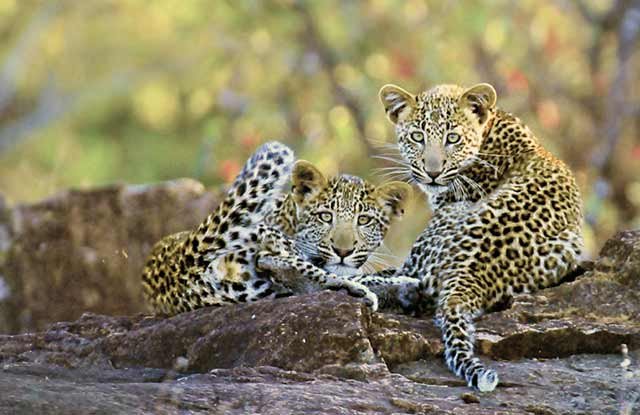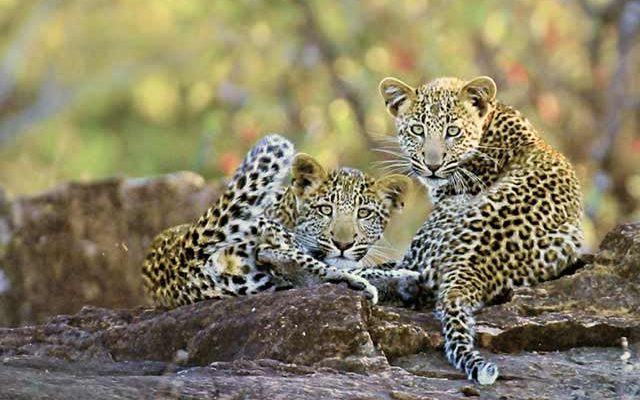
Imagine a mom leopard, fiercely protective yet gentle with her tiny cubs, teaching them how to navigate their world. It’s like a tough-love parenting style, where one moment, she’s snuggling with them, and the next, she’s showcasing her hunting prowess. This dynamic is not just about survival; it’s about preparing for a life in a sometimes harsh wilderness. Let’s dive deeper into how African leopards, like our friendly neighborhood momma leopard, raise their young in the wild.
Finding the Perfect Den
To kick things off, let’s talk about where it all begins—denning. After a gestation period of about 90 to 105 days, a female leopard searches for a safe place to give birth. She typically chooses a secluded spot, often in caves, dense bushes, or even abandoned burrows. This choice is crucial because it keeps her cubs hidden from predators and other risks.
The ideal den needs to provide shelter and security. Think of it as finding a cozy hideout for your kids—a place where they can grow up without constant threats. Once she finds this haven, she’ll settle in and give birth to a litter usually consisting of two to four cubs. However, it’s not uncommon for leopards to have just one cub or up to six.
Welcoming the New Arrivals
Once the cubs arrive, their mother becomes incredibly devoted. For the first few weeks, she stays close to them, nursing and keeping them warm. Here’s the thing: these little fur balls are born blind and helpless, relying entirely on her. This dependency means she has to be cautious about her movements and stay vigilant for potential dangers, like other predators or even male leopards, who might pose a threat.
During this early stage, the mother leopard’s care is paramount. She’ll clean her cubs, help them build strength through gentle play, and keep them in a safe environment. Honestly, that nurturing phase is critical because it sets the groundwork for their future survival skills. Cubs start to open their eyes at around two weeks old, and soon, they’ll be exploring their den.
Playtime and Learning
Once the cubs are a few weeks old, they enter a playful phase. This is more than just fun and games—it’s essential for their development. Through play, they learn important skills like stalking, pouncing, and the social dynamics they’ll need as they grow. Picture a round of hide-and-seek in the tall grass, where every rustle teaches them something new about their environment.
Mother leopards often join in on the fun. She might initiate a little friendly wrestling match, demonstrating how to use their claws and teeth. It’s a beautiful mix of affection and education, like when a parent plays catch with their child, but with a wild twist. These lessons are vital, as they must master these skills for when they eventually need to hunt for food themselves.
Transitioning to Independence
By the time the cubs reach about three months old, they start to venture out with their mother on short trips. She begins to introduce them to solid food, often bringing back small kills for them to nibble on. This is a pivotal moment in their upbringing; they learn not just how to eat but also develop a taste for various prey.
Leopards are solitary hunters, so teaching cubs how to stalk and catch food is crucial. The mother uses this time to monitor their progress closely, offering guidance and correction as needed. Have you ever watched a child learning to ride a bike? The first wobbly attempts are messy. But with practice, they get better. That’s exactly what’s happening here.
Facing Challenges Together
Life in the wild isn’t easy. As the cubs grow, they will face numerous challenges. One significant threat is the presence of male leopards, who may kill cubs to bring a female back into estrus. This survival tactic means the mother leopard must be extra cautious. She often moves her cubs to new hiding spots to stay one step ahead of potential dangers.
Additionally, she has to ensure they remain hidden from larger predators like lions or hyenas that could pose a threat. It’s a constant balancing act between teaching her young and keeping them safe. Imagine being a single parent while trying to juggle work, school, and the wrath of the neighborhood bullies. It’s tough!
Gradual Separation
Around the age of 18 months, the mother begins to push her cubs towards independence. This is a natural part of the process; she knows they must learn to fend for themselves. She still keeps an eye on them, but it’s time for the cubs to step out into the world. This moment can be bittersweet, as it’s her way of letting go while ensuring they are equipped with the skills needed for survival.
During this phase, the mother may still provide occasional meals. However, she encourages her cubs to hunt on their own, reinforcing what she’s taught them. It’s like cheering your kids on as they take their first steps into the world—exciting but a little nerve-wracking, too.
A Legacy of Independence
Eventually, once the cubs have honed their skills and feel confident, they will leave their mother’s territory to establish their own. This step is essential for their growth—it allows them to claim their space and find their mates in the future. Just like many of us do when we graduate and start our own lives, these leopards embark on a journey of independence, carrying the lessons learned from their mother.
The bond formed during those early months lays the foundation for their survival. They’ll carry with them not just physical skills but also the instincts and habits they developed alongside their mother. This generational legacy is what makes the species thrive in the wild.
In the end, raising leopard cubs in the wild is a remarkable journey of love, learning, and survival. From selecting the perfect den to teaching their cubs how to hunt, mother leopards invest a tremendous amount of energy and care into ensuring their young grow up strong and capable. It’s not just about having cubs; it’s about preparing them for the harsh realities of life in the wild.
The process is a striking reminder of the circle of life. The skills and instincts passed down through generations equip these leopards to thrive in a challenging environment. So, next time you picture a leopard, remember the incredible story behind those majestic spots. It’s a tale woven through love, lessons, and the wild rhythms of nature.

